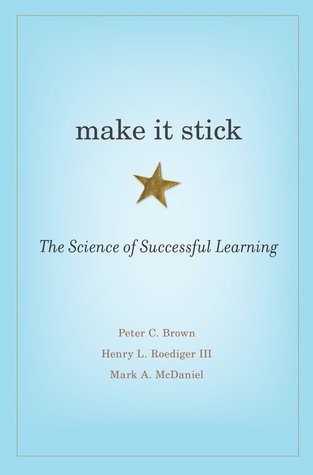
Top 5 Education Books I Read Last Year
It’s the first day of the year, and I have been reflecting back on 2018. Last year I set a reading challenge of 52 books for myself on Goodreads, and I made it. Many of the books I read were about education or mathematics. Here is a list of my 5 favorites, in no particular order. I will be posting my own reviews over the next few weeks.
- Teach Students How to Learn: Strategies You Can Incorporate Into Any Course to Improve Student Metacognition, Study Skills, and Motivation
- Power-Up: Unlocking the Hidden Mathematics in Video Games
- Make It Stick: The Science of Successful Learning
- How We Learn: The Surprising Truth About When, Where, and Why It Happens
- The New Education: How to Revolutionize the University to Prepare Students for a World In Flux
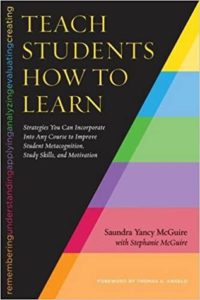 Teach Students How to Learn: Strategies You Can Incorporate Into Any Course to Improve Student Metacognition, Study Skills, and Motivation
Teach Students How to Learn: Strategies You Can Incorporate Into Any Course to Improve Student Metacognition, Study Skills, and Motivation
by Saundra Yancy McGuire (Author), Thomas Angelo (Foreword), Stephanie McGuire (Contributor)
Goodreads Synopsis:
Miriam, a freshman Calculus student at Louisiana State University, made 37.5% on her first exam but 83% and 93% on the next two. Matt, a first year General Chemistry student at the University of Utah, scored 65% and 55% on his first two exams and 95% on his third–These are representative of thousands of students who decisively improved their grades by acting on the advice described in this book.
What is preventing your students from performing according to expectations? Saundra McGuire offers a simple but profound answer: If you teach students how to learn and give them simple, straightforward strategies to use, they can significantly increase their learning and performance.
For over a decade Saundra McGuire has been acclaimed for her presentations and workshops on metacognition and student learning because the tools and strategies she shares have enabled faculty to facilitate dramatic improvements in student learning and success. This book encapsulates the model and ideas she has developed in the past fifteen years, ideas that are being adopted by an increasing number of faculty with considerable effect.
The methods she proposes do not require restructuring courses or an inordinate amount of time to teach. They can often be accomplished in a single session, transforming students from memorizers and regurgitators to students who begin to think critically and take responsibility for their own learning.
Saundra McGuire takes the reader sequentially through the ideas and strategies that students need to understand and implement. First, she demonstrates how introducing students to metacognition and Bloom’s Taxonomy reveals to them the importance of understanding how they learn and provides the lens through which they can view learning activities and measure their intellectual growth. Next, she presents a specific study system that can quickly empower students to maximize their learning. Then, she addresses the importance of dealing with emotion, attitudes, and motivation by suggesting ways to change students’ mindsets about ability and by providing a range of strategies to boost motivation and learning; finally, she offers guidance to faculty on partnering with campus learning centers.
She pays particular attention to academically unprepared students, noting that the strategies she offers for this particular population are equally beneficial for all students.
While stressing that there are many ways to teach effectively, and that readers can be flexible in picking and choosing among the strategies she presents, Saundra McGuire offers the reader a step-by-step process for delivering the key messages of the book to students in as little as 50 minutes. Free online supplements provide three slide sets and a sample video lecture.
This book is written primarily for faculty but will be equally useful for TAs, tutors, and learning center professionals. For readers with no background in education or cognitive psychology, the book avoids jargon and esoteric theory.
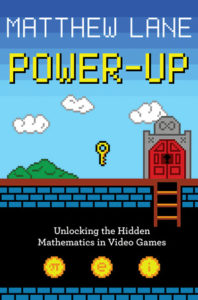 Power-Up: Unlocking the Hidden Mathematics in Video Games
Power-Up: Unlocking the Hidden Mathematics in Video Games
by Matthew Lane
Goodreads Synopsis:
A fun and lively look at the mathematical ideas concealed in video games
Did you know that every time you pick up the controller to your PlayStation or Xbox, you are entering a game world steeped in mathematics? Power-Up reveals the hidden mathematics in many of today’s most popular video games and explains why mathematical learning doesn’t just happen in the classroom or from books–you’re doing it without even realizing it when you play games on your cell phone.
In this lively and entertaining book, Matthew Lane discusses how gamers are engaging with the traveling salesman problem when they play Assassin’s Creed, why it is mathematically impossible for Mario to jump through the Mushroom Kingdom in Super Mario Bros., and how The Sims teaches us the mathematical costs of maintaining relationships. He looks at mathematical pursuit problems in classic games like Missile Command and Ms. Pac-Man, and how each time you play Tetris, you’re grappling with one of the most famous unsolved problems in all of mathematics and computer science. Along the way, Lane discusses why Family Feud and Pictionary make for ho-hum video games, how realism in video games (or the lack of it) influences learning, what video games can teach us about the mathematics of voting, the mathematics of designing video games, and much more.
Power-Up shows how the world of video games is an unexpectedly rich medium for learning about the beautiful mathematical ideas that touch all aspects of our lives–including our virtual ones.
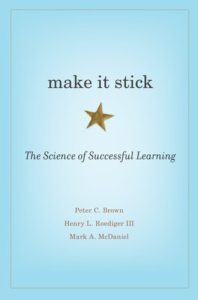 Make It Stick: The Science of Successful Learning
Make It Stick: The Science of Successful Learning
by Peter C. Brown, Henry L. Roediger III, Mark A. McDaniel
Goodreads Synopsis:
To most of us, learning something “the hard way” implies wasted time and effort. Good teaching, we believe, should be creatively tailored to the different learning styles of students and should use strategies that make learning easier. Make It Stick turns fashionable ideas like these on their head. Drawing on recent discoveries in cognitive psychology and other disciplines, the authors offer concrete techniques for becoming more productive learners.
Memory plays a central role in our ability to carry out complex cognitive tasks, such as applying knowledge to problems never before encountered and drawing inferences from facts already known. New insights into how memory is encoded, consolidated, and later retrieved have led to a better understanding of how we learn. Grappling with the impediments that make learning challenging leads both to more complex mastery and better retention of what was learned.
Many common study habits and practice routines turn out to be counterproductive. Underlining and highlighting, rereading, cramming, and single-minded repetition of new skills create the illusion of mastery, but gains fade quickly. More complex and durable learning come from self-testing, introducing certain difficulties in practice, waiting to re-study new material until a little forgetting has set in, and interleaving the practice of one skill or topic with another. Speaking most urgently to students, teachers, trainers, and athletes, Make It Stick will appeal to all those interested in the challenge of lifelong learning and self-improvement.
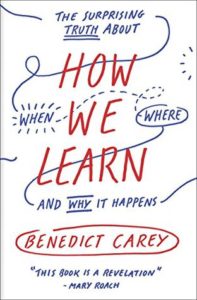 How We Learn: The Surprising Truth About When, Where, and Why It Happens
How We Learn: The Surprising Truth About When, Where, and Why It Happens
by Benedict Carey
Goodreads Synopsis:
In the tradition of The Power of Habit and Thinking, Fast and Slow comes a practical, playful, and endlessly fascinating guide to what we really know about learning and memory today—and how we can apply it to our own lives.
From an early age, it is drilled into our heads: Restlessness, distraction, and ignorance are the enemies of success. We’re told that learning is all self-discipline, that we must confine ourselves to designated study areas, turn off the music, and maintain a strict ritual if we want to ace that test, memorize that presentation, or nail that piano recital.
But what if almost everything we were told about learning is wrong? And what if there was a way to achieve more with less effort?
In How We Learn, award-winning science reporter Benedict Carey sifts through decades of education research and landmark studies to uncover the truth about how our brains absorb and retain information. What he discovers is that, from the moment we are born, we are all learning quickly, efficiently, and automatically; but in our zeal to systematize the process we have ignored valuable, naturally enjoyable learning tools like forgetting, sleeping, and daydreaming. Is a dedicated desk in a quiet room really the best way to study? Can altering your routine improve your recall? Are there times when distraction is good? Is repetition necessary? Carey’s search for answers to these questions yields a wealth of strategies that make learning more a part of our everyday lives—and less of a chore.
By road testing many of the counterintuitive techniques described in this book, Carey shows how we can flex the neural muscles that make deep learning possible. Along the way he reveals why teachers should give final exams on the first day of class, why it’s wise to interleave subjects and concepts when learning any new skill, and when it’s smarter to stay up late prepping for that presentation than to rise early for one last cram session. And if this requires some suspension of disbelief, that’s because the research defies what we’ve been told, throughout our lives, about how best to learn.
The brain is not like a muscle, at least not in any straightforward sense. It is something else altogether, sensitive to mood, to timing, to circadian rhythms, as well as to location and environment. It doesn’t take orders well, to put it mildly. If the brain is a learning machine, then it is an eccentric one. In How We Learn, Benedict Carey shows us how to exploit its quirks to our advantage.
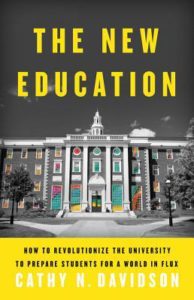 The New Education: How to Revolutionize the University to Prepare Students for a World In Flux
The New Education: How to Revolutionize the University to Prepare Students for a World In Flux
by Cathy N. Davidson
Goodreads Synopsis:
A leading educational thinker argues that the American university is stuck in the past–and shows how we can revolutionize it for our era of constant change
Our current system of higher education dates to the period from 1865 to 1925, when the nation’s new universities created grades and departments, majors and minors, in an attempt to prepare young people for a world transformed by the telegraph and the Model T. As Cathy N. Davidson argues in The New Education, this approach to education is wholly unsuited to the era of the gig economy. From the Ivy League to community colleges, she introduces us to innovators who are remaking college for our own time by emphasizing student-centered learning that values creativity in the face of change above all. The New Education ultimately shows how we can teach students not only to survive but to thrive amid the challenges to come.